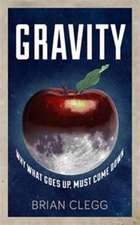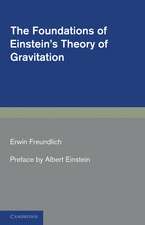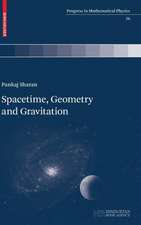Gravity: Where Do We Stand?
Editat de Roberto Peron, Monica Colpi, Vittorio Gorini, Ugo Moschellaen Limba Engleză Paperback – 27 mar 2019
The majority of the contributions deals with the manifold facets of “experimental gravitation”, but the book goes beyond this and covers a broad range of subjects from the foundations of gravitational theories to astrophysics and cosmology.
The book is divided into three parts. The first part deals with foundations and Solar System tests. An introductory pedagogical chapter reviews first Newtonian gravitational theory, special relativity, the equivalence principle and the basics of general relativity. Then it focuses on approximation methods, mainly the post-Newtonian formalism and the relaxed Einstein equations, with a discussion on how they are used in treating experimental tests and in the problem of generation and detection of gravitational waves. Following this is a set of chapters describing the most recent experiments, techniques and observations on the testing of gravity theories in the laboratory, around the Earth and in the Solar System.
The second part is dedicated to astrophysical topics deeply linked with the study of gravitation, namely binary pulsars and the perspective of direct detection of gravitational waves. These cases are paradigmatic in that the gravitational signals act at the same time as messengers helping us to understand the properties of important and wide classes of astrophysical objects.
The third part explores the many open issues in current knowledge of gravitation machinery, especially related to astrophysical and cosmological problems and the way possible solutions to them impact the quest for a quantum theory of gravitation and unified theory. Included is a selection of the many possiblepaths, giving a hint to the subtleties one is called upon. Whenever possible, a close link to observational constraints and possible experimental tests is provided.
In selecting the topics of the various contributions, particular care has been devoted to ensure their fit in a coherent representation of our understanding of gravitational phenomena. The book is aimed at graduate level students and will form a valuable reference for those working in the field.
| Toate formatele și edițiile | Preț | Express |
|---|---|---|
| Paperback (1) | 399.88 lei 6-8 săpt. | |
| Springer International Publishing – 27 mar 2019 | 399.88 lei 6-8 săpt. | |
| Hardback (1) | 407.39 lei 6-8 săpt. | |
| Springer International Publishing – 18 dec 2015 | 407.39 lei 6-8 săpt. |
Preț: 399.88 lei
Nou
Puncte Express: 600
Preț estimativ în valută:
76.52€ • 80.09$ • 63.69£
76.52€ • 80.09$ • 63.69£
Carte tipărită la comandă
Livrare economică 31 martie-14 aprilie
Preluare comenzi: 021 569.72.76
Specificații
ISBN-13: 9783319793009
ISBN-10: 3319793004
Pagini: 484
Ilustrații: XIV, 484 p. 130 illus., 103 illus. in color.
Dimensiuni: 155 x 235 mm
Greutate: 0.69 kg
Ediția:Softcover reprint of the original 1st ed. 2016
Editura: Springer International Publishing
Colecția Springer
Locul publicării:Cham, Switzerland
ISBN-10: 3319793004
Pagini: 484
Ilustrații: XIV, 484 p. 130 illus., 103 illus. in color.
Dimensiuni: 155 x 235 mm
Greutate: 0.69 kg
Ediția:Softcover reprint of the original 1st ed. 2016
Editura: Springer International Publishing
Colecția Springer
Locul publicării:Cham, Switzerland
Cuprins
Introduction.- Gravity: Newtonian, post-Newtonian and General Relativistic.- Newtonian Gravity and its classical tests (Equivalence Principle, Measure of G, 1/r2 dependence).- Gravitational Tests with Interplanetary Probes.- Probing gravity with second generation lunar laser ranging.- Fundamental physics with the LAGEOS satellites.- The role of binary pulsars in testing Gravity Theories.- Gravitational waves: theory, sources, detectors.- Possible low energy manifestations of strings and gravity.- Effective Field Theories with Lorentz Violations and their observational constraints.- Search for generic violations of Lorentz invariance in the Standard Model Extension formalism.- The MOND-TeVeS theory and the lensing results from the Bullet Cluster.
Notă biografică
Roberto Peron
Istituto di Fisica dello Spazio Interplanetario – Istituto Nazionale di Astrofisica
Vittorio Gorini
Dipartimento di Fisica e Matematica, Università dell’Insubria, Como, Italy
Ugo Moschella
Dipartimento di Fisica e Matematica, Università dell’Insubria, Como, Italy
Istituto di Fisica dello Spazio Interplanetario – Istituto Nazionale di Astrofisica
Vittorio Gorini
Dipartimento di Fisica e Matematica, Università dell’Insubria, Como, Italy
Ugo Moschella
Dipartimento di Fisica e Matematica, Università dell’Insubria, Como, Italy
Textul de pe ultima copertă
This book presents an overview of the current understanding of gravitation, with a focus on the current efforts to test its theories, especially general relativity. It shows how the quest for a deeper understanding, which would possibly incorporate gravity in the quantum realm, is more than ever an open field.
The majority of the contributions deals with the manifold facets of “experimental gravitation”, but the book goes beyond this and covers a broad range of subjects from the foundations of gravitational theories to astrophysics and cosmology.
The book is divided into three parts. The first part deals with foundations and Solar System tests. An introductory pedagogical chapter reviews first Newtonian gravitational theory, special relativity, the equivalence principle and the basics of general relativity. Then it focuses on approximation methods, mainly the post-Newtonian formalism and the relaxed Einstein equations, with a discussion on how they are used in treating experimental tests and in the problem of generation and detection of gravitational waves. Following this is a set of chapters describing the most recent experiments, techniques and observations to test the theories of gravitation in the laboratory, around the Earth and in the Solar System.
The second part is dedicated to astrophysical topics deeply linked with the study of gravitation, namely binary pulsars and the perspective of direct detection of gravitational waves. These cases are paradigmatic in that the gravitational signals act at the same time as messengers helping us to understand the properties of important and wide classes of astrophysical objects.
The third part explores the many open issues in the current knowledge of gravitation machinery, especially related to astrophysical and cosmological problems, and the way possible solutions to them impact the quest for a quantum theory of gravitation and unified theory. Included is a selection of the manypossible paths, giving a hint to the subtleties one is called upon. Whenever possible, a close link to observational constraints and possible experimental tests is provided.
In selecting the topics of the various contributions, particular care has been devoted to ensure their fit in a coherent representation of our understanding of gravitational phenomena. The book is aimed at graduate level students and will form a valuable reference for those working in the field.
The majority of the contributions deals with the manifold facets of “experimental gravitation”, but the book goes beyond this and covers a broad range of subjects from the foundations of gravitational theories to astrophysics and cosmology.
The book is divided into three parts. The first part deals with foundations and Solar System tests. An introductory pedagogical chapter reviews first Newtonian gravitational theory, special relativity, the equivalence principle and the basics of general relativity. Then it focuses on approximation methods, mainly the post-Newtonian formalism and the relaxed Einstein equations, with a discussion on how they are used in treating experimental tests and in the problem of generation and detection of gravitational waves. Following this is a set of chapters describing the most recent experiments, techniques and observations to test the theories of gravitation in the laboratory, around the Earth and in the Solar System.
The second part is dedicated to astrophysical topics deeply linked with the study of gravitation, namely binary pulsars and the perspective of direct detection of gravitational waves. These cases are paradigmatic in that the gravitational signals act at the same time as messengers helping us to understand the properties of important and wide classes of astrophysical objects.
The third part explores the many open issues in the current knowledge of gravitation machinery, especially related to astrophysical and cosmological problems, and the way possible solutions to them impact the quest for a quantum theory of gravitation and unified theory. Included is a selection of the manypossible paths, giving a hint to the subtleties one is called upon. Whenever possible, a close link to observational constraints and possible experimental tests is provided.
In selecting the topics of the various contributions, particular care has been devoted to ensure their fit in a coherent representation of our understanding of gravitational phenomena. The book is aimed at graduate level students and will form a valuable reference for those working in the field.
Caracteristici
Presents authors who are leading experts in the field Represents state-of-the-art contributions in authors' respective areas Contains an introductory pedagogical chapter Includes supplementary material: sn.pub/extras














